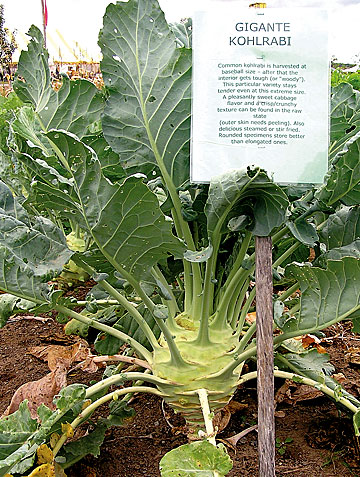 |
| One section of MOFGA’s demonstration garden highlighted storage crops that are easy to grow and can supply healthful produce throughout the winter, such as celeriac and ‘Gigante’ kohlrabi. English photo. |
 |
| Celeriac. English photo. |
 |
| ‘Gigante’ kohlrabi. English photo. |
A demonstration plot planted last summer at MOFGA’s Common Ground Education Center highlighted storage crops – vegetables that are easy to store over winter indoors without canning or freezing and, in some cases, can even be left in the ground over winter for an early spring harvest. Most last longest in a cool, slightly damp root cellar; onions store well in a cool, dry space; carrots and beets last longest when preserved in damp sand or sawdust, or among dry leaves in a barrel in a cool corner of a cellar. Here are 12 crops to try, along with comments by Jack Kertesz, MOFGA’s demonstration gardens coordinator. These 12 don’t take up much room in the garden. Planting just a 20-foot row of each of these should produce at least 200 pounds of vegetables – meeting about half the annual per capita vegetable consumption in the United States.
Onions – Start seeds indoors in February or March and transplant seedlings to the garden in early spring, or plant sets (small onions, available from garden supply outlets) directly in the garden in early spring. Check seed catalogs for varieties that store well.
Leeks – If you can find some nice seedlings in the spring, or start your own seedlings by sowing seeds indoors in February, these are well worth growing. Their mild onion flavor and simple cooking properties are well suited to the humble home kitchen. Leek and potato soup takes on a gratifying richness when home grown, warming heart and soul. Check seed catalogs for varieties that store well.
Shallots – This onion relative stores very well and should keep until a spring onion is ready in the garden. Shallots can be started from seed sown indoors at the same time as onions; by direct seeding outdoors in early spring; or by planting sets (individual shallots) in early spring – or in fall, along with garlic.
Celeriac – More commonly grown in Europe, the enlarged root of celeriac can be diced and cooked in soups or winter stews or grated raw for salads. It is also juiced and found in healthful blends with beets and carrots, providing a mild celery-like flavor. Start seeds indoors in March, transplant seedlings to the garden in the spring and transform your winter fare.
‘Gigante’ kohlrabi – Common kohlrabi is harvested at baseball size; after that the interior gets tough or “woody.” The ‘Gigante’ variety stays tender even at the extreme, not-quite-soccer-ball size that it achieved in the Common Ground plot. The raw vegetable, after being peeled, has a pleasantly sweet cabbage flavor and a crispy/crunchy texture. Cooked, it is delicious steamed or stir-fried. Rounded specimens store better than elongated ones.
Cabbage – Choose a storage type for winter use. Some people prefer to harvest the whole plant, roots and all, and hang them upside down in a cool, moist root cellar. Outer, sometimes nasty looking leaves can be removed, yielding a choice interior.
Parsnips – A spring tradition is to dig these oh-so-sweet roots from the garden. They are excellent drizzled with oil and roasted on a cookie sheet. Or try a parsnip pie: Sauté sliced parsnips and onions in corn oil, place them in a crust and bake until the parsnips are soft. You will look forward to spring’s first bounty.
Turnips and rutabagas – Served in the traditional way – cooked and mashed – or grilled/roasted, these orbs help us celebrate our “roots.” This New England staple, which some will turnup their nose to, will store until spring with cool temperatures and high humidity.
Storage carrots – Late planted (the first week of July at MOFGA), suitable varieties of carrots can be stored in the ground for future harvests. One method is to cut the tops off and to cover the roots with a layer of soil or freshly raked leaves. A layer of plastic, layer of straw, and a final layer of plastic complete the insulation. A hoop system with row cover and additional plastic can also be employed. If deer frequent your garden, throw a wire screen on top of the plot in the fall. Sweet, crunchy carrots dug fresh in January are a welcomed perk-me-up for the palate.
Black Spanish radish – Not everyone’s cup of tea, these zesty radishes can add some fire to your early winter salads or can be roasted with mixed vegetables.
Beets – Sow seeds in early to mid-July for fall harvest and storage.
Potatoes – Of course. Plant seed (actually egg-sized sections of potato tubers with eyes on each section) from spring through early summer. Potatoes in the demonstration plot were planted on July 7. Hill the plants as they grow (pulling soil up to the stems, or mulching heavily with straw, or plant seed pieces through black plastic). Dig the harvest in fall, after frost has killed the foliage.

